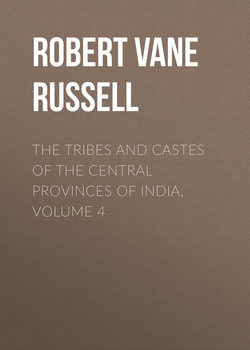Читать книгу The Tribes and Castes of the Central Provinces of India, Volume 4 - Robert Vane Russell - Страница 27
Part II
Articles on Castes and Tribes
Kumhār—Yemkala
Vol. IV
Kunbi
14. Disposal of the dead
ОглавлениеThe Kunbis either bury or burn the dead. In Berār sepulture is the more common method of disposal, perhaps in imitation of the Muhammadans. Here the village has usually a field set apart for the disposal of corpses, which is known as Smashān. Hindus fill up the earth practically level with the ground after burial and erect no monument, so that after a few years another corpse can be buried in the same place. When a Kunbi dies the body is washed in warm water and placed on a bier made of bamboos, with a network of san-hemp.34 Ordinary rope must not be used. The mourners then take it to the grave, scattering almonds, sandalwood, dates, betel-leaf and small coins as they go. These are picked up by the menial Mahārs or labourers. Halfway to the grave the corpse is set down and the bearers change their positions, those behind going in front. Here a little wheat and pulse which have been tied in the cloth covering the corpse are left by the way. On the journey to the grave the body is covered with a new unwashed cloth. The grave is dug three or four feet deep, and the corpse is buried naked, lying on its back with the head to the south. After the burial one of the mourners is sent to get an earthen pot from the Kurnhār; this is filled with water at a river or stream, and a small piece is broken out of it with a stone; one of the mourners then takes the pot and walks round the corpse with it, dropping a stream of water all the way. Having done this, he throws the pot behind him over his shoulder without looking round, and then all the mourners go home without looking behind them. The stone with which the hole has been made in the earthen pot is held to represent the spirit of the deceased. It is placed under a tree or on the bank of a stream, and for ten days the mourners come and offer it pindas or balls of rice, one ball being offered on the first day, two on the second, and so on, up to ten on the tenth. On this last day a little mound of earth is made, which is considered to represent Mahādeo. Four miniature flags are planted round, and three cakes of rice are laid on it; and all the mourners sit round the mound until a crow comes and eats some of the cake. Then they say that the dead man’s spirit has been freed from troubling about his household and mundane affairs and has departed to the other world. But if no real crow comes to eat the cake, they make a representation of one out of the sacred kusha grass, and touch the cake with it and consider that a crow has eaten it. After this the mourners go to a stream and put a little cow’s urine on their bodies, and dip ten times in the water or throw it over them. The officiating Brāhman sprinkles them with holy water in which he has dipped the toe of his right foot, and they present to the Brāhman the vessels in which the funeral cakes have been cooked and the clothes which the chief mourner has worn for ten days. On coming home they also give him a stick, umbrella, shoes, a bed and anything else which they think the dead man will want in the next world. On the thirteenth day they feed the caste-fellows and the head of the caste ties a new pagri on the chief mourner’s head backside foremost; and the chief mourner breaking an areca-nut on the threshold places it in his mouth and spits it out of the door, signifying the final ejectment of the deceased’s spirit from the house. Finally, the chief mourner goes to worship at Maroti’s shrine, and the household resumes its ordinary life. The different relatives of the deceased man usually invite the bereaved family to their house for a day and give them a feast, and if they have many relations this may go on for a considerable time. The complete procedure as detailed above is observed only in the case of the head of the household, and for less important members is considerably abbreviated. The position of chief mourner is occupied by a man’s eldest son, or in the absence of sons by his younger brother, or failing him by the eldest son of an elder brother, or failing male relations by the widow. The chief mourner is considered to have a special claim to the property. He has the whole of his head and face shaved, and the hair is tied up in a corner of the grave-cloth. If the widow is chief mourner a small lock of her hair is cut off and tied up in the cloth. When the corpse is being carried out for burial the widow breaks her mangalsūtram or marriage necklace, and wipes off the kunku or vermilion from her forehead. This necklace consists of a string of black glass beads with a piece of gold, and is always placed on the bride’s neck at the wedding. The widow does not break her glass bangles at all, but on the eleventh day changes them for new ones.
34
Crotalaria juncea.
